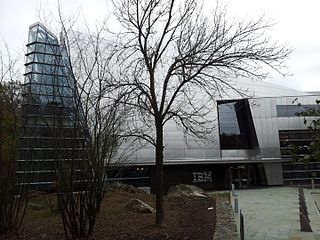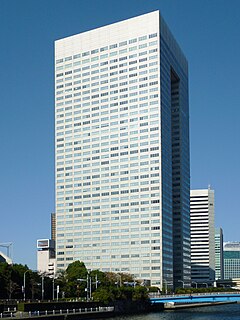
Mainframe computers or mainframes are computers used primarily by large organizations for critical applications; bulk data processing, such as census, industry and consumer statistics, enterprise resource planning; and transaction processing. They are larger and have more processing power than some other classes of computers: minicomputers, servers, workstations, and personal computers.
IBM PC compatible computers are computers similar to the original IBM PC, XT, and AT, able to use the same software and expansion cards. Such computers used to be referred to as PC clones, or IBM clones. They duplicate almost exactly all the significant features of the PC architecture, facilitated by IBM's choice of commodity hardware components and various manufacturers' ability to reverse engineer the BIOS firmware using a "clean room design" technique. Columbia Data Products built the first clone of the IBM personal computer by a clean room implementation of its BIOS.
Wintel is a portmanteau of Microsoft Windows and Intel, referring to personal computers using Intel x86-compatible processors running Microsoft Windows.

IBM PC DOS is a discontinued operating system for the IBM Personal Computer, manufactured and sold by IBM from the early 1980s into the 2000s. Before version 6.1, PC DOS was an IBM-branded version of MS-DOS. From version 6.1 on, PC DOS became IBM's independent product.

CP/M-86 was a version of the CP/M operating system that Digital Research (DR) made for the Intel 8086 and Intel 8088. The system commands are the same as in CP/M-80. Executable files used the relocatable .CMD file format. Digital Research also produced a multi-user multitasking operating system compatible with CP/M-86, MP/M-86, which later evolved into Concurrent CP/M-86. When an emulator was added to provide PC DOS compatibility, the system was renamed Concurrent DOS, which later became Multiuser DOS, of which REAL/32 is the latest incarnation. The DOS Plus, FlexOS, and DR DOS families of operating systems started as derivations of Concurrent DOS as well.

FM Towns system is a Japanese variant of PC, built by Fujitsu from February 1989 to the summer of 1997. It started as a proprietary PC variant intended for multimedia applications and PC games, but later became more compatible with regular PCs. In 1993, the FM Towns Marty was released, a game console compatible with existing FM Towns games.

The PC-8800 series, commonly shortened to PC-88, are a brand of Zilog Z80-based 8-bit home computers released by Nippon Electric Company (NEC) in 1981 and primarily sold in Japan

The MPU-401, where MPU stands for MIDI Processing Unit, is an important but now obsolete interface for connecting MIDI-equipped electronic music hardware to personal computers. It was designed by Roland Corporation, which also co-authored the MIDI standard.

The PC-9800 series, commonly shortened to PC-98 or 98, is a lineup of Japanese 16-bit and 32-bit personal computers manufactured by NEC from 1982 through 2000. The platform established NEC's dominance in the Japanese personal computer market, and by 1999, more than 18 million PC-98 units had been sold.

AX was a Japanese computing initiative starting in around 1986 to allow PCs to handle double-byte (DBCS) Japanese text via special hardware chips, whilst allowing compatibility with software written for foreign IBM PCs. It was developed by a consortium including ASCII Corporation, Sony, Hitachi, Sharp, Oki, Casio, Canon, Kyocera, Sanyo, Mitsubishi Electric, etc. with cooperation of Microsoft. but notably excluding Toshiba and Fujitsu. At that time, NEC PC-9801 was the dominant PC architecture in the Japanese PC market because MDA/CGA was not adequate for handling Japanese. However, NEC did not tolerate PC-9801 compatible machines and was fighting court battles with Epson which was the only PC-9801 compatible machine vendor. Therefore other vendors desperately needed a standard specification for Japanese capable PCs.
CE Linux Forum, otherwise known as the Consumer Electronics Linux Forum or CELF, is a non-profit organization that works to advance Linux as an open source platform for consumer electronics (CE) devices. It has a primarily technical focus, working on specifications, implementations, conferences and testing to help Linux developers improve Linux for use in CE products.

The Toshiba T1000 was a laptop computer manufactured by the Toshiba Corporation in 1987. It had a similar specification to the IBM PC Convertible, with a 4.77 MHz 80C88 processor, 512 kB of RAM, and a monochrome CGA-compatible LCD. Unlike the Convertible, it includes a standard serial port and parallel port, connectors for an external monitor, and a real-time clock.
NetWare Lite and Personal NetWare are a series of discontinued peer-to-peer local area networks developed by Novell for DOS- and Windows-based personal computers aimed at personal users and small businesses in the 1990s.

Following the introduction of the IBM Personal Computer, or IBM PC, many other personal computer architectures became extinct within just a few years.

The Personal System/55 (パーソナルシステム/55) or PS/55 was a personal computer series released from IBM Japan in 1987.





















